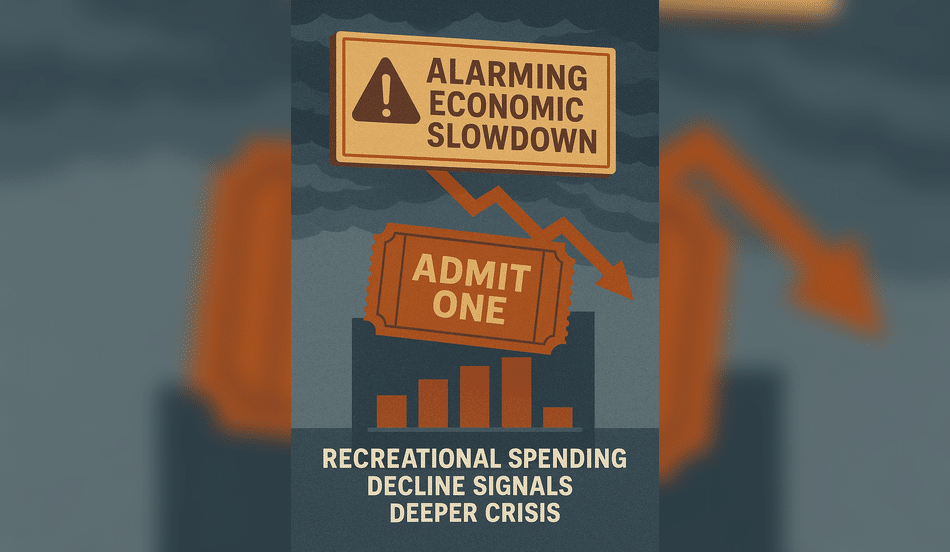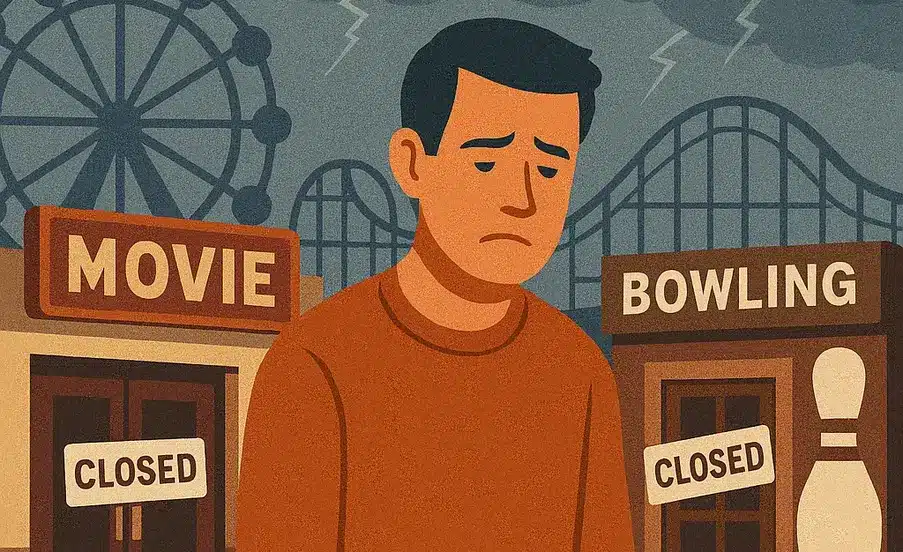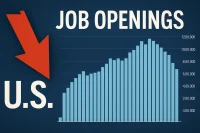In a concerning development for the US economy, a second round of revisions to first-quarter GDP has confirmed what many economists feared – the economic contraction wasn’t merely due to import-related tariff distortions. Instead, consumer spending, particularly discretionary spending on services, took a significant hit. This revelation, coupled with recent announcements from companies like Winnebago, suggests we’re witnessing early warning signs of a potentially serious economic slowdown that could extend well beyond 2025’s first quarter.
The Recreational Vehicle Industry: A Critical Economic Canary in the Coal Mine
Recreational vehicle manufacturer Winnebago recently delivered troubling news that has economic analysts concerned. The company reported that weakness in consumer spending didn’t just affect the first quarter but continued into the second quarter and appears poised to persist into the third. While some might dismiss RV sales as inconsequential to broader economic health, recreational spending actually serves as a crucial early indicator of economic trouble.
Why Recreational Spending Matters
Recreational spending, particularly on big-ticket items like RVs, provides valuable insights into consumer confidence and discretionary income trends:
- When Americans feel financially secure and optimistic about future earnings, they’re willing to invest in recreational vehicles and activities
- Cutbacks in recreational spending often precede broader reductions in consumer spending
- The Bureau of Economic Analysis specifically tracks “recreational goods and vehicles” as a distinct GDP component due to its economic significance
- In Q4 2024, recreational goods and vehicle spending contributed a substantial 0.3 percentage points to the overall 2.4% GDP growth rate
“Growing macroeconomic uncertainty led to a notable downshift in RV activity from consumers and dealers as the third quarter progressed,” explained Winnebago CEO Michael Happe during a recent analyst call. “These challenges are likely to continue through the remainder of the calendar year.”
Learn how economic indicators affect your job security
📢 Hiring? Navigate Economic Uncertainty with Strategic Talent Acquisition
In challenging economic times, finding qualified candidates who can help your business weather uncertainty becomes even more critical. WhatJobs connects employers with motivated talent seeking stability in an unstable job market.
Post your open roles with confidence and attract applicants who are ready to adapt, lead, and grow.
👉 Post Jobs for Free with WhatJobsGDP Revisions Reveal Deeper Consumer Spending Problems
The latest government data paints an increasingly concerning picture about the state of consumer spending, which drives approximately 70% of the US economy.
Dramatic Downward Revisions
The evolution of consumer spending estimates for Q1 2025 tells a troubling story:
- Initial estimates: Personal consumption expenditures increased by 1.8%
- First revision: Growth reduced to just 1.18% (weakest since the 2023 banking crisis)
- Latest revision: Growth further slashed to merely 0.46% (worst performance since Q2 2020)
These dramatic downward revisions suggest the economic situation was significantly worse than initially reported. Service spending, which typically adds 1.2-1.5 percentage points to GDP, contributed just 0.3 points in Q1 2025—the smallest contribution since the pandemic’s early days.
Beyond Import Distortions
While many economic commentators initially focused on import and trade distortions as the primary cause of negative GDP, the data increasingly points to fundamental consumer weakness:
- Real final sales to domestic purchasers (purchases by American consumers and businesses regardless of production origin) grew at just 1.48%—the slowest since 2022
- Real final sales of domestic product (sales of American goods/services regardless of purchase location) contracted by 3.1%
- All seven major categories of services spending were revised lower in the latest figures
Explore recession-resistant career opportunities
The Labor Market Connection: Jobs Driving Consumer Behavior
The transcript makes a compelling case that changing consumer behavior isn’t simply about negative sentiment or overreaction to economic news—it reflects genuine concerns about employment prospects.
Employment Uncertainty Becomes Certainty
Despite Federal Reserve Chairman Jerome Powell’s insistence that the job market remains “solid,” evidence suggests consumers are responding to deteriorating employment conditions:
- Continued jobless claims have shown concerning increases
- Consumers consistently cite jobs as their top economic concern
- Discretionary spending pullbacks typically correlate with employment insecurity
- The economy appears to be transitioning to what economists call “the flat part of the Beveridge curve”—a concerning indicator of labor market health
“The jobs market is not solid and its prospects continue to get worse all the time—and consumers know it,” notes the economic analysis. “This is the ‘uncertainty’ that everybody keeps talking about. But the economy is becoming more certain, not less. It’s just that the way in which it’s becoming more certain doesn’t look like the way J. Powell has been selling everybody.”

Understand how global economic shifts affect job markets
Capital Expenditure Surge: Temporary Distortion
The one apparent bright spot in Q1 GDP data—a 10.3% increase in business capital expenditures—appears to be largely unsustainable:
- Equipment spending added 1.11 percentage points to GDP
- Information processing equipment (particularly computers) drove half this increase
- Analysts attribute much of this surge to tariff front-loading
- This temporary boost likely won’t continue into subsequent quarters
This means the economy faces a potential double challenge: continued consumer spending weakness coupled with an inevitable decline in the capital expenditure that temporarily masked some of Q1’s problems.
Federal Reserve Response: Dovish Shift Becoming Inevitable
The mounting evidence of economic weakness is forcing even inflation-focused Federal Reserve officials to acknowledge downside risks.
Breaking Ranks with Powell
While Chairman Powell continues emphasizing economic strength despite “uncertainty,” other FOMC members are beginning to express concerns:
- Federal Reserve Governor Michelle Bowman recently acknowledged “recent softness in spending and signs of fragility in the labor market”
- Market rates continue moving lower, with the 10-year Treasury yield dropping to 4.27% and the 2-year approaching 3.7%
- Bond markets are increasingly pricing in multiple rate cuts
“The evidence is showing up everywhere,” the analysis states. “We have a very strong case that the US economy is at the very least in this transition stage described by the Beveridge curve moving to the flat part of it.”
Protecting Yourself in an Economic Downturn
With mounting evidence pointing to a potential economic slowdown, Americans should consider taking proactive steps to protect their financial well-being:
Financial Preparation Strategies
- Build emergency savings while employed to create a financial buffer
- Reduce discretionary spending before it becomes necessary
- Consider recession-resistant career paths that remain stable during economic downturns
- Develop multiple income streams to reduce dependency on a single employer
- Review investment portfolios for exposure to cyclical industries
Employment Protection Measures
- Enhance job skills that remain valuable during economic contractions
- Network aggressively to uncover hidden job opportunities
- Research growing sectors that might continue hiring despite broader slowdowns
- Consider geographic flexibility to access stronger job markets
Find recession-resistant job opportunities on WhatJobs
FAQ: Understanding Economic Slowdown Warning Signs
What makes recreational spending like RVs an important economic slowdown warning sign?
Recreational spending, particularly on big-ticket items like RVs, serves as a leading indicator of broader economic trends because it’s among the first discretionary expenses consumers cut when feeling financially insecure. When Americans reduce recreational vehicle purchases, it often signals declining confidence in future income and employment prospects. The Bureau of Economic Analysis specifically tracks recreational spending as a distinct GDP component precisely because these economic slowdown warning signs appear here before affecting other sectors.
How significant are the recent GDP revisions in signaling an economic slowdown?
The dramatic downward revisions to Q1 2025 GDP data represent significant economic slowdown warning signs. Consumer spending growth was initially reported at 1.8%, then revised to 1.18%, and finally to just 0.46%—the worst since Q2 2020. Service spending, which typically contributes 1.2-1.5 percentage points to GDP, added just 0.3 points. These revisions indicate the economic contraction wasn’t merely due to tariff-related trade distortions but reflects fundamental consumer weakness that could signal a broader economic slowdown.
How is the labor market connected to these economic slowdown warning signs?
Employment concerns appear to be driving many of the economic slowdown warning signs we’re observing. Despite Federal Reserve claims of a “solid” job market, increasing continued jobless claims and consumer surveys consistently citing jobs as their top economic concern suggest deteriorating employment conditions. When consumers worry about job security, they naturally reduce discretionary spending, creating a feedback loop that can accelerate economic slowdown warning signs as businesses respond with hiring freezes or layoffs.
What actions should individuals take in response to these economic slowdown warning signs?
Given the mounting economic slowdown warning signs, individuals should consider building emergency savings, reducing unnecessary expenses, exploring recession-resistant career paths, and developing multiple income streams. Additionally, enhancing job skills that remain valuable during contractions, networking to uncover hidden opportunities, and researching growing sectors can help protect against potential employment disruptions. Taking proactive steps before a full-blown slowdown materializes provides more options and financial flexibility.




